
Thalassoma bifasciatum, the bluehead, bluehead wrasse or blue-headed wrasse, is a species of marine ray-finned fish, a wrasse from the family Labridae. It is native to the coral reefs of the tropical waters of the western Atlantic Ocean. Individuals are small and rarely live longer than two years. They form large schools over the reef and are important cleaner fish in the reefs they inhabit.
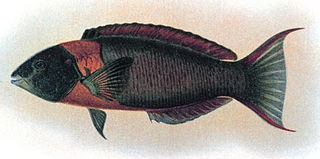
Thalassoma is a genus of wrasses native to the Atlantic, Indian and Pacific Oceans. Many species occasionally make their way into the aquarium trade.

The moon wrasse also known as the crescent wrasse or lyretail wrasse, is a species of wrasse native to the Indian Ocean and the western Pacific Ocean. It is an inhabitant of coral reefs and surrounding areas at depths from 1 to 20 m. Moon wrasses are carnivorous and tend to prey on fish eggs and small sea-floor dwelling invertebrates. This species can reach 45 cm (18 in) in total length. It is of minor importance to local commercial fisheries and can also be found in the aquarium trade.

The slippery dick is a species of wrasse native to shallow, tropical waters of the western Atlantic Ocean.
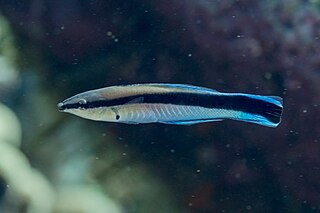
The bluestreak cleaner wrasse, Labroides dimidiatus, is one of several species of cleaner wrasses found on coral reefs from Eastern Africa and the Red Sea to French Polynesia. Like other cleaner wrasses, it eats parasites and dead tissue off larger fishes' skin in a mutualistic relationship that provides food and protection for the wrasse, and considerable health benefits for the other fishes.

The Christmas wrasse, also known as the ladder wrasse, green-barred wrasse or green-blocked wrasse, is a species of ray-finned fish, a wrasse from the family Labridae which is native to the Indian Ocean and the western Pacific Ocean. It inhabits shallow reefs at depths from the surface to 10 m (33 ft). It is of minor importance to local commercial fisheries and can be found in the aquarium trade.

Jansen's wrasse is a species of ray-finned fish, a wrasse from the family Labridae which is native to the Indian Ocean and Pacific Ocean. In the south-western Pacific Ocean it is replaced by sibling species black-barred wrasse. It can be found in the aquarium trade.

The bird wrasse, Gomphosus varius, is a species of the wrasse family.

The eight-lined wrasse is a species of marine ray-finned fish, a wrasse from the family Labridae, which is native to the Indian and Pacific Oceans. It occurs on coral reefs at depths from 2 to 50 m, preferring to shelter in niches and caves. It can also be found in the aquarium trade.
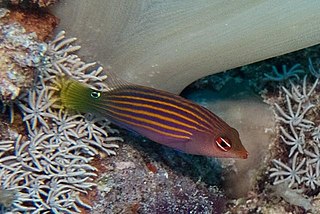
The six-line wrasse is a species of marine ray-finned fish from the family Labridae which has a wide Indo-Pacific distribution. This species is associated with coral reefs and can be found in the aquarium trade.

The saddle wrasse, also known as Hīnālea Lauwili in Hawaiʻi, is a species of wrasse native to the waters around the Hawaiian Islands and Johnston Island. They are found on reefs at depths from 5 to 25 m. This species can reach 28 cm (11 in) in total length. This species can also be found in the aquarium trade.

The sixbar wrasse or six-banded wrasse is a species of wrasse in the family Labridae, native to the Indian Ocean and the western Pacific Ocean. It is an inhabitant of reef environments at depths from the surface down to 15 m (50 ft). This species can grow to 20 cm (8 in) in total length, though most individuals do not exceed 15 cm (6 in). It is of minor importance to local commercial fisheries and can also be found in the aquarium trade.
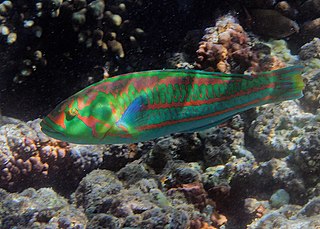
The surge wrasse, also known as the green-blocked wrasse, purple wrasse or red and green wrasse, is a species of wrasse native to the southeast Atlantic Ocean through the Indian and Pacific Oceans, where it inhabits reefs and rocky coastlines in areas of heavy wave action at depths from the surface to 10 m (33 ft). This species is of minor importance to local commercial fisheries, is popular as a game fish, and can be found in the aquarium trade.
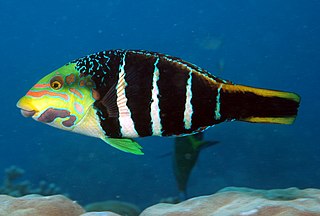
The barred thicklip wrasse is a species of fish belonging to the wrasse family, native from the Indo-Pacific.

The broomtail wrasse is a species of wrasse native to the Red Sea and Indian Ocean.

The pearly razorfish, commonly known as cleaver wrasse, is a species of wrasse. It is of minor importance to local commercial fisheries and is popular as a game fish. It can also be found in the aquarium trade.

Halichoeres prosopeion, commonly called the twotone wrasse, half-grey wrasse or zig-zag wrasse, is a fish species in the wrasse family native to the western Pacific Ocean.

Halichoeres richmondi, commonly called the Richmond's wrasse or chain-lined wrasse, is a fish species in the wrasse family native from the central Indo-Pacific.
Pseudojuloides cerasinus, the smalltail wrasse or the pencil wrasse, is a species of marine ray-finned fish, a wrasse from the family Labridae. It is found in the tropical Pacific Ocean and was previously considered to have a much wider distribution but the recognition of new species has reduced this wide range.
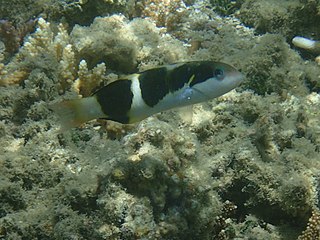
The black-barred wrasse is a species of ray-finned fish, a wrasse from the family Labridae which is native to the southwestern Pacific Ocean.




















